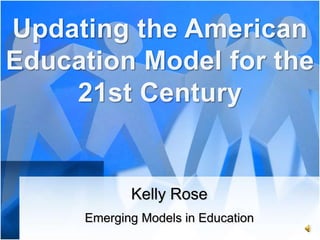
E D U 6054 Kelly Rose With Sound
- 1. Kelly Rose Emerging Models in Education
- 3. Problems with Our 2 Current Educational Model… • Too much emphasis on testing. • No Child Left Behind punishes schools that do not meet Adequate Yearly Progress reports. “The previous law was too punitive. It was too prescriptive. It lowered the bar for students and too often narrowed the curriculum…” ---Arne Duncan, U.S. Secretary of Education at a press conference on March 15, 2010
- 4. Problems with Our 3 Current Educational Model… • Not enough time to cover everything that is required for the tests and include other fun activities. = Extend school hours and/or days. According to Malcolm Gladwell (2008): “ …America doesn't have a school problem. It has a summer vacation problem…” (p. 260).
- 6. Shift from the Teacher- Centered 5 Instructional model. • Emphasize cooperative learning and group work. • Some of the many benefits include: – Greater student achievement. – Social benefits for students. – Suits the changing work enviro. – Classroom costs reduced.
- 7. Shift from the Teacher- Centered 6 Instructional model. • Projects and student portfolios instead of exams. In School In the Workplace = Students will develop the social skills required in the “right brained” workforce.
- 10. Technology Incorporated 9 Throughout All Curriculums. • Online learning should be encouraged, not penalized by schools. • Schools should provide technical support and offer credit to students who successfully complete online courses.
- 11. More Support for Students. 10 • Quality career planning and support. • Encourage job training programs and internships for students during school breaks. • Senior high schools offer more flexibility and curriculum tracts based on a student`s intended career.
- 12. More Support for Students. 11 • Add an advisory/ homeroom period every day. Students can get individualized attention and discuss problems with their homeroom teacher. • Reduce classroom size in all classes (core as well as elective/ advisory). – Dennis Littky`s Mets schools demonstrates how a reduced class size at the secondary level can be successful.
- 13. Encourage Responsibility. 12 • Encourage students to take on more responsibility in their daily lives such as: – Daily planners, lunch helpers, etc. Schools already have these programs, however the implementation is haphazard and lacks connection to broader area of life. – Monitor their grades and communicate with teachers. Both in person as well as using technology such as online grading/ test scores and teacher blogs/ emails. – Volunteer/ charity projects outside of school. Cultivates an appreciation in students and a connectedness between the student and community.
- 14. Encourage Leadership. 13 • Club activities and sports. Students can foster important character-building and self-esteem raising traits through such programs. • Through group projects and collaboration in school. If we shift away from the teacher-centered model and favor peer collaboration projects, students will develop leadership and organizational skills naturally.
- 15. Revolutionary? Not Really. 14 • Many of these ideas are already implemented in American schools (especially the Met Schools). – However, there is no consistent implementation with all teachers, grade levels, schools, districts and states yet. =The ideas presented should be evenly distributed throughout all areas of American public schools. Current teachers must be trained and schools must be remodeled to facilitate cooperative learning and technological instruction.
- 16. Final Thoughts 15 • We are slowly seeing signs of change. – Recently the Obama Administration announced the reauthorization of the Elementary and Secondary Education Act. = This act trumps NCLB and offering flexibility to schools, among many other goals. • Hopefully these ideas presented and others will be adopted in our public schools in the very near future.
- 17. Thank you for viewing!
- 18. References 16 Bemak, Fred (George Mason University). (2007, December 3). A Generation in Jeopardy: Today’s Youth, Tomorrow’s Future. The Vision Series. Video retrieved from http://www.researchchannel.org Christensen, C. M., Horn, M.B., & Johnson, C.W. (2008). Disrupting Class: How Disruptive Innovation Will Change the Way the World Learns. New York: McGraw-Hill. Conde, Sara. (2005, April 5). A Lesson for the Education System. The Telegraph. Retrieved from http://www.smh.com.au/articles/2005/04/04/1112489413929.html Dahely, Andrew M. (1994). Cooperative Learning Classroom Research. Retrieved from http://alumni.media.mit.edu/~andyd/mindset/design/clc_rsch.html Gee, James Paul. (2003). What Video Games Have to Teach Us About Learning and Literacy. New York: Palgrave/ Macmillan. Gladwell, Malcolm. (2008). Outliers: The Story of Success. New York: Little, Brown and Company. Kolb, Liz. (2007). Toys to Tools: Connecting Student Cell Phones to Education. Retrieved from http://.myneu.neu.edu Pink, Daniel H. Education and the Changing World of Work. Discovery Education. Video retrieved from http://www.youtube.com/watch?v=ykq6XSO0c0M United States Department of Education. A Blueprint for Reform: Reauthorization of the Elementary and Secondary Education Act (Data file). Retrieved from http://www2.ed.gov/policy/elsec/leg/blueprint/index.html